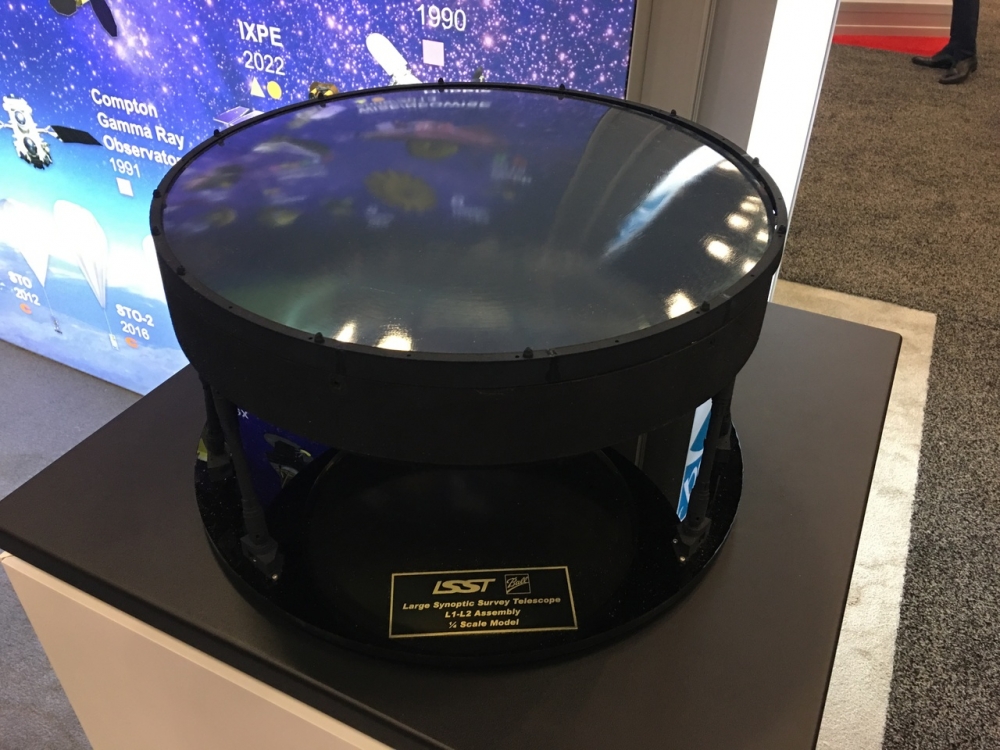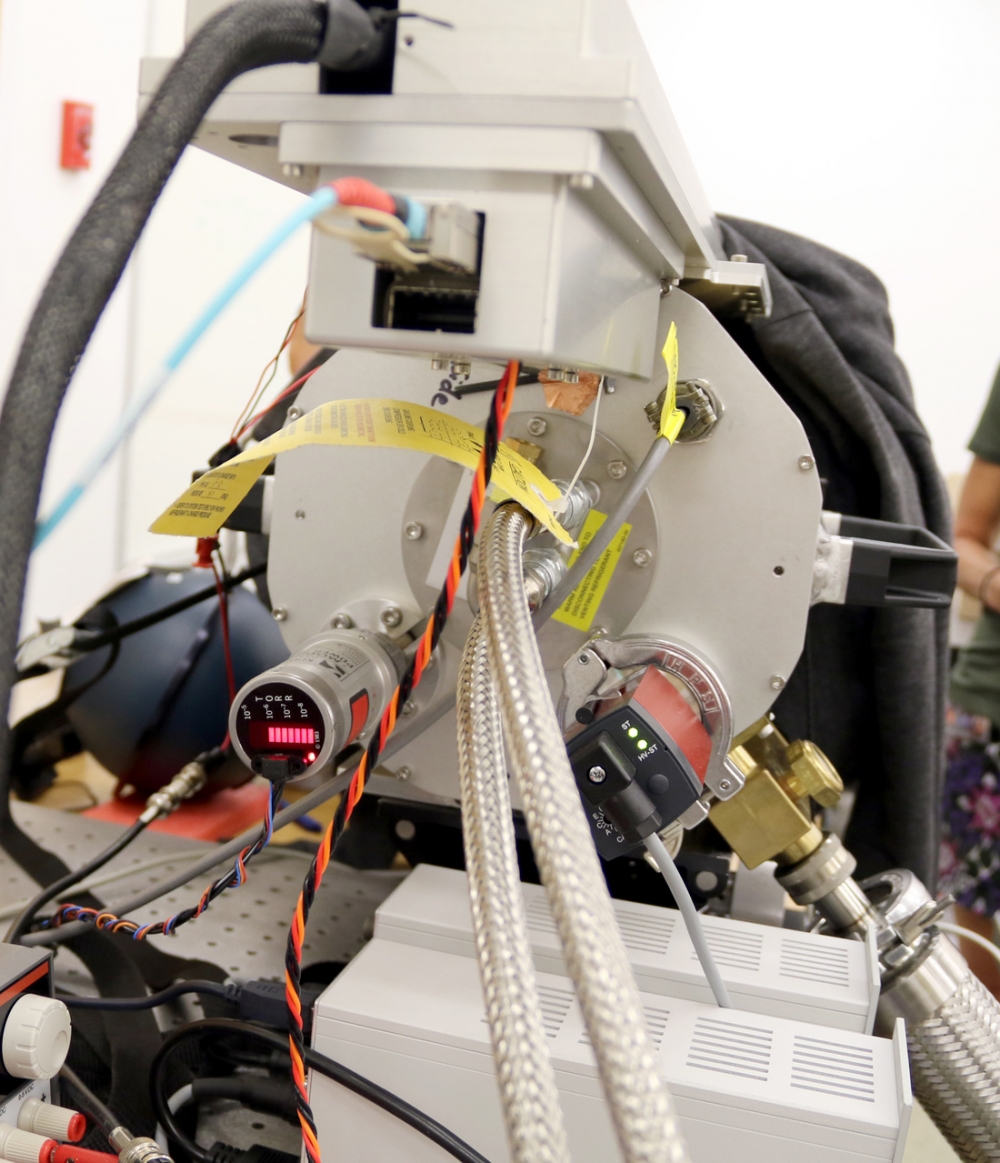Don’t forget to register for LSST 2018 using this link. The deadline for registration is July 9.
LSST was mentioned in a recent article by Ellen Meyer (UMBC) about the future of astronomy and data, originally published in The Conversation and re-printed in the San Francisco Chronicle and at Smithsonian.com.
In Spain, a reception was held at the factory of LSST vendor Asturfeito on May 14 to acknowledge the significance of the work completed on the Telescope Mount Assembly (TMA). Approximately 200 people attended, including local government officials and industry dignitaries. A news article describing the event can be found here.
Installation of the first summit network equipment took place on Cerro Pachón at the beginning of May. After readying the summit computer room, which included ensuring the space was appropriately clean and temperature-controlled, the IT team began installing servers in this space, which will serve as the central hub of communications on Cerro Pachón. Read more about the installation in this recent news post.
in Tucson, preparations are underway for the assembly and testing of the calibration equipment that will be mounted on the Auxiliary Telescope (AT) in order to measure atmospheric transmission during LSST operations. In early May, the cryostat and associated peripherals arrived at the Project Office workshop in Tucson. The cryostat contains the sensor that will be used to image spectra from the AT’s spectrograph, cooling it to a temperature of -100 degrees Celsius (-150 F) Read more details in this news post.
New photos showing construction progress on the Summit Facility on Cerro Pachón are now available in the LSST Gallery.
Did you know you can order clothing items featuring the LSST logo at Land’s End? Use this link to browse and place your order.
PERSONNEL NEWS
Dr. Leanne Guy joined LSST on May 14 as the Data Management (DM) Subsystem Scientist. In this role, Leanne will ensure DM initiatives provide solutions that meet the overall LSST science goals by leading the definition and understanding of these goals and communicating them to the DM engineering team. Leanne will also be a member of the Change Control Board and the Project Science Team.
New employment opportunities with LSST are now open for applications: Senior Optics Lead (Tucson/Chile), Electronics Engineer (Chile), and EPO Senior Software Engineer (Tucson). These and other open positions with LSST can be found at this link.
UPCOMING MEETINGS with LSST INVOLVEMENT
(those with asterisk* are LSSTC funded):
2018 | |
June 4-8 | TVSSC (Transient and Variable Stars Science Collaboration) Survey Strategy Proposal Preparation Workshop, Lehigh University, Bethlehem, PA* |
June 10-15 | SPIE Astronomical Telescopes and Instrumentation Meeting, Austin, TX |
June 11-15 | LSST@Europe3, Lyon, France* |
June 19-21 | Data Visualization and Exploration in the LSST Era, University of IL/NCSA, Champaign, IL* |
July 10-12 | 1st Solar System Science Collaboration Science Readiness Sprint, Seattle, Washington.* |
July 23-27 | LSST Dark Energy Science Collaboration meeting, DE School and Sprint Day, Carnegie Mellon University PA* |
July 30-Aug 3 | NSF/DOE Joint Status Review, Tucson, AZ |
August 13-17 | LSST Project and Community Workshop 2018, Tucson, AZ |
Noticias del Proyecto & Científicas
No olvide registrarse para LSST 2018 utilizando este enlace this link. La fecha límite de inscripción es el 9 de julio.
LSST fue mencionado en un artículo reciente por Ellen Meyer (UMBC) sobre el futuro de la astronomía y datos, publicado originalmente en The Conversation y re-impreso en el San Francisco Chronicle y en Smithsonian.com.
En España, hubo una recepción en la fábrica del proveedor de LSST Asturfeito el 14 de mayo para reconocer la importancia de la labor realizada en el Montaje del Telescopio (TMA). Asistieron aproximadamente 200 personas, incluyendo funcionarios del gobierno local y personalidades de la industria. Un artículo de noticias describiendo el evento puede ser encontrado aquí.
La instalación de los primeros equipos de red en la montaña tomó lugar en Cerro Pachón a principios de mayo. Después de la preparación de la sala de computadores, la que incluyo la aseguración de que el espacio estuviese apropiadamente limpio y a temperatura controlada, el equipo de Informática empezó a instalar los servidores en este espacio, que servirá como el centro de comunicaciones en Cerro Pachón. Lea más acerca de la instalación en this recent news post.
En Tucson, se están realizando preparativos para el ensamblaje y el ensayo del equipo de calibración que será montado en el Telescopio Auxiliar (TA) para medir la transmisión atmosférica durante las operaciones de LSST. A principios de mayo, el criostato y periféricos asociados llegaron al taller de la Oficina del Proyecto en Tucson. El criostato contiene el sensor que se utilizarán para hacer una imagen del espectro en el espectrógrafo el TA, enfriándolo a una temperatura de -100 grados Celsius (-150 F) Leer más detalles en in this news post.
Nuevas fotos mostrando el progreso de la construcción en las Instalaciones de la Cumbre en Cerro Pachón están disponibles ahora en LSST Gallery.
¿Sabía usted que puede ordenar artículos de ropa con el logotipo LSST en Land's End? Utilice este enlace this link para navegar y realizar su pedido.
Noticias de Personal
La Dra. Leanne Guy se unió a LSST el 14 de mayo como científico del subsistema de Gestión de Datos (DM). En este rol, Leanne garantizará que las iniciativas de DM proporcionaran soluciones que satisfagan los objetivos generales de la ciencia con LSST dirigiendo la definición y comprensión de estos objetivos y comunicarlos al equipo de ingeniería de DM. Leanne también será un miembro de la Junta de Control de Cambios y del Equipo Científico del Proyecto.
Nuevas oportunidades de empleo con LSST están ahora disponibles para postular: Senior Optics Lead (Tucson/Chile), Ingeniero Electrónico (Chile), y Ingeniero Software Senior para EPO (Tucson). Estos y otros puestos disponibles con LSST pueden encontrarse en este enlace this link.
Próximas reuniones con participación de LSST
(aquellos con un asterisco* son financiados por LSSTC):
2018 | |
Junio 4-8 | TVSSC (Transient and Variable Stars Science Collaboration) Survey Strategy Proposal Preparation Workshop, Lehigh University, Bethlehem, PA* |
Junio 10-15 | SPIE Reunión de Telescopios e Instrumentación Astronómica, Austin, TX |
Junio 11-15 | LSST@Europe3, Lyon, Francia* |
Junio 19-21 | Visualización de Datos y Exploración en la Época de LSST, Universidad de IL/NCSA, Champaign, IL* |
Julio 10-12 | 1st Solar System Science Collaboration Science Readiness Sprint, Seattle, Washington.* |
Julio 23-27 | Reunion LSST Dark Energy Science Collaboration, DE School and Sprint Day, Carnegie Mellon University PA* |
Julio 30-Agosto 3 | NSF/DOE Joint Status Review, Tucson, AZ |
Agosto 13-17 | Taller del Proyecto y Comunitario LSST 2018, Tucson, AZ |











